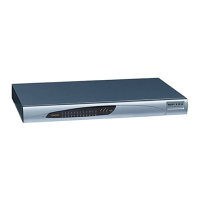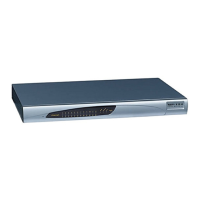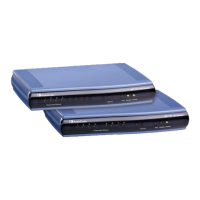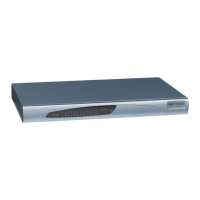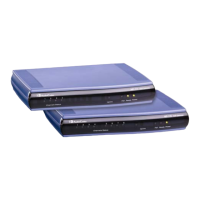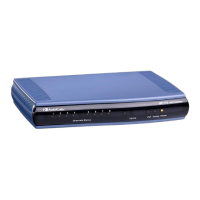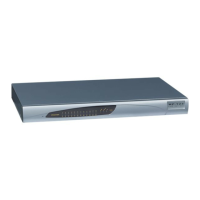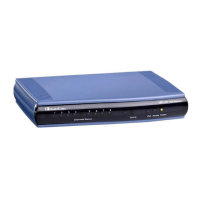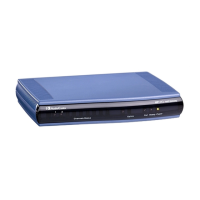
Do you have a question about the AudioCodes MP-124 and is the answer not in the manual?
| Model | MP-124 |
|---|---|
| Category | Gateway |
| Analog Ports | 24 FXS |
| Ethernet Ports | 2 |
| Protocol Support | SIP, H.323 |
| Fax Support | T.38, G.711 pass-through |
| Power Supply | 100-240VAC, 50-60Hz |
| Operating Temperature | 0°C to 40°C |
| Voice Codecs | G.711, G.729, G.723.1, G.726 |
| Management | SNMP |
| Storage Temperature | -20°C to 70°C |
| Humidity | 10% to 90%, non-condensing |
| Network Interface | 10/100Base-T Ethernet |
Lists the necessary computer requirements for using the device's Web interface.
Provides instructions on how to open and access the device's Web interface.
Lists the necessary computer requirements for using the device's Web interface.
Provides instructions on how to open and access the device's Web interface.
Allows configuration of various networking parameters like IP settings, routing, and QoS.
Configures logical network interfaces, IP addresses, VLAN IDs, and application types.
Configures various security settings, including user accounts and firewall.
Configures the device's SIP parameters, including enabling applications and protocol definitions.
Configures the main SIP protocol parameters, including general and DTMF settings.
Configures SIP proxy servers, registration parameters, and IP Groups for call routing.
Configures the Stand-Alone Survivability (SAS) feature for telephony continuity.
Configures call routing rules, including general parameters and specific routing tables.
Configures parameters associated with supplementary services like Call Forward and Call Waiting.
Configures the Stand-Alone Survivability (SAS) feature for local backup during network failures.
Defines Tel-to-IP call routing rules based on IP address or FQDN.
Defines user name and password for authenticating each device port.
Allows forwarding (redirecting) IP-to-Tel calls to other ports or destinations.
Configures Hunt Group IDs, assigns them to channels, and defines methods for call assignment.
Configures the device's management parameters like settings, regional settings, and maintenance actions.
Remotely resets the device, with options to save configuration to flash memory.
Guides through upgrading the device's firmware (cmp file) and loading configuration files.
Saves the current configuration as an ini file for backup or restores configuration from a saved ini file.
Monitors device channels, Syslog messages, hardware/software info, and statistics.
Details the rules for formatting ini file names and content.
Details configuring the IPSec protocol for secure communication between EMS and the device.
Describes the device's networking parameters, including Ethernet and IP configurations.
Describes IP network interfaces and VLAN parameters for configuring logical IP addresses.
Describes the device's Web and Telnet parameters for remote access and management.
Describes the device's debugging and diagnostic parameters.
Describes Call Detail Record (CDR) and debug parameters for call logging and troubleshooting.
Describes the device's security parameters, including general settings, HTTPS, SRTP, TLS, and SSH.
Describes Secure Hypertext Transport Protocol (HTTPS) parameters for secure web access.
Describes Transport Layer Security (TLS) parameters for secure connections.
Describes Secure Shell (SSH) parameters for strong authentication.
Describes Internet Protocol security (IPSec) parameters for network security.
Describes the device's SIP parameters, including general and advanced settings.
Describes the general SIP parameters for session setup and management.
Configures the device to operate with SAS for telephony continuity during network failures.
Configures emergency number redirection to PSTN via the SAS agent.
Supports the North American emergency telephone number system (E911) for routing calls to PSAP.
Details FXO device interworking SIP E911 calls from IP network to analog PSAP DID lines.
Details supported transport modes for fax/modem, including T.38 relay and bypass.
Negotiates T.38 capabilities using Re-INVITE messages upon fax signal detection.
Switches to T.38 mode automatically upon fax signal detection without SIP Re-INVITE.
Uses bypass mode for V.34 fax transmission to enable full speed utilization.
Describes FXO operating modes for IP-to-Tel calls including One-stage and Two-stage dialing.
Defines telephone numbers automatically dialed when a specific FXS or FXO port is used.
Supports methods for identifying when a call has been terminated by the PBX.
Compares destination number prefixes to routing table entries for alternative route selection.
Describes how to place a call on hold and retrieve it using hook-flash.
Configures up to 16 different IP addresses with associated VLANs using the Multiple Interface table.
